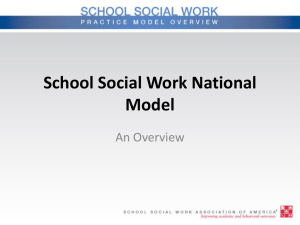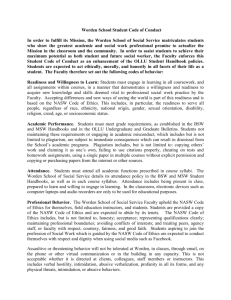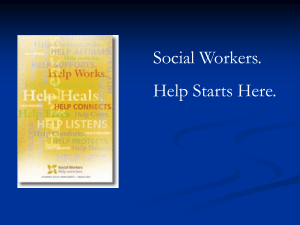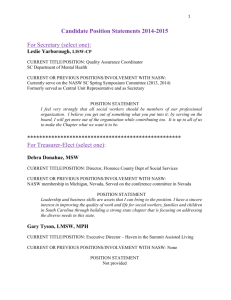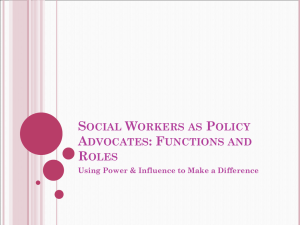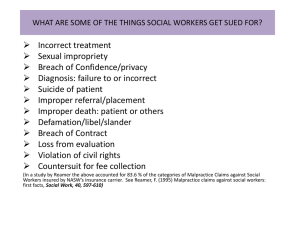Education of Children and Youths Issue Section In the United States
advertisement
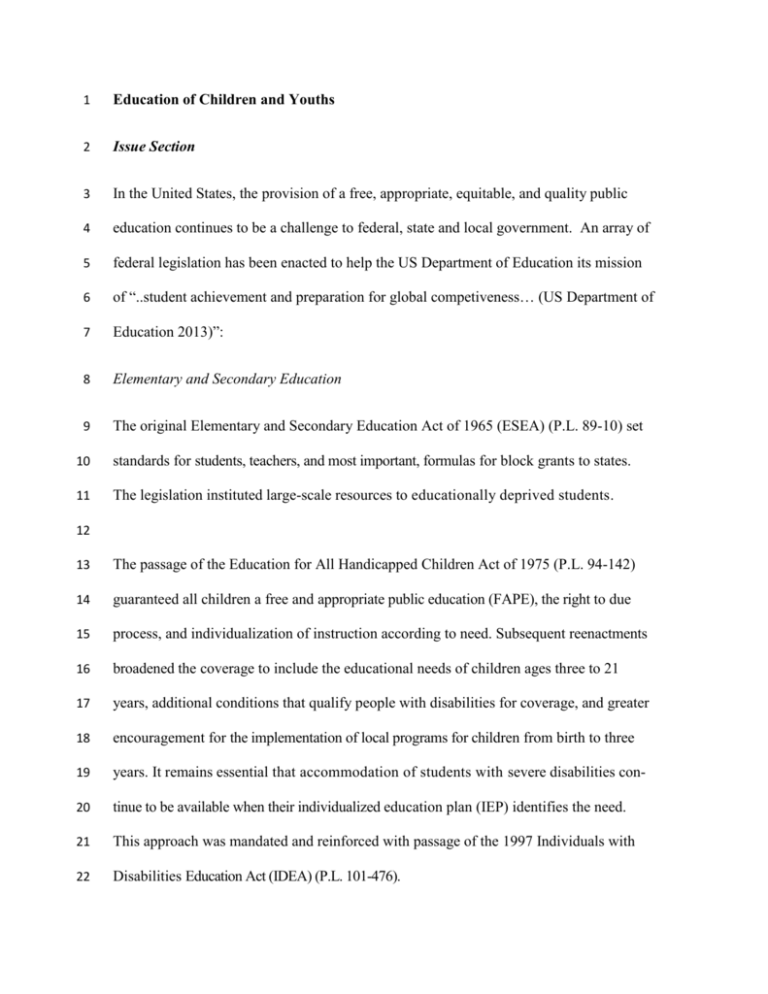
1 Education of Children and Youths 2 Issue Section 3 In the United States, the provision of a free, appropriate, equitable, and quality public 4 education continues to be a challenge to federal, state and local government. An array of 5 federal legislation has been enacted to help the US Department of Education its mission 6 of “..student achievement and preparation for global competiveness… (US Department of 7 Education 2013)”: 8 Elementary and Secondary Education 9 The original Elementary and Secondary Education Act of 1965 (ESEA) (P.L. 89-10) set 10 standards for students, teachers, and most important, formulas for block grants to states. 11 The legislation instituted large-scale resources to educationally deprived students. 12 13 The passage of the Education for All Handicapped Children Act of 1975 (P.L. 94-142) 14 guaranteed all children a free and appropriate public education (FAPE), the right to due 15 process, and individualization of instruction according to need. Subsequent reenactments 16 broadened the coverage to include the educational needs of children ages three to 21 17 years, additional conditions that qualify people with disabilities for coverage, and greater 18 encouragement for the implementation of local programs for children from birth to three 19 years. It remains essential that accommodation of students with severe disabilities con- 20 tinue to be available when their individualized education plan (IEP) identifies the need. 21 This approach was mandated and reinforced with passage of the 1997 Individuals with 22 Disabilities Education Act (IDEA) (P.L. 101-476). 23 24 The 2004 Individuals with Disabilities Education Improvement Act (P.L. 108-446), a 25 revision of IDEA, calls on educational institutions to demonstrate improved outcomes for 26 all students. 27 28 The 2002 No Child Left Behind Act (P.L. 107-110) was implemented and “laid 29 emphasis on the idea of accountability, adding timelines and sanctions for not 30 achieving goals (Jonson-Reid 2008)”. 31 32 Post-Secondary Education 33 The post-secondary education system can be classified as adult education (workforce 34 development and literacy) and higher education (community colleges, state college and 35 university systems) (Jonson-Reid 2008). The 1964 Economic Opportunity Act (P.L. 88-452) 36 and the 1965 Higher Education Act (P.L. 105-244) are amongst federal legislation aimed at 37 post-secondary education for civilian US citizens. 38 39 Population Specific 40 Specific legislation that mandates continuous services to transient or homeless students was 41 established in 1987 by the Stewart B. McKinney Homeless Assistance Act (P.L. 100-77), 42 which has been amended and later became known as the McKinney-Vento Act. 43 44 Populations affected 45 Public education is a vital socializing force that, with the family, promotes the total 46 development of the child intellectually, socially, and physically. To nurture the full 47 potential of children and youths, our nation’s public schools are an excellent forum to ensure 48 equal opportunity and preparation. NASW believes that schools must pursue excellence 49 and provide for the physical and emotional safety and growth, in addition to the 50 education, of children. Schools must identify students with disabilities and disadvantages 51 early and provide support to such students in accordance with federal legislation. 52 Educational environments promote transitional learning in the areas of work, community 53 living, and civic responsibility. 54 55 Students with excessive truancy and who are at risk of dropping out must receive outreach 56 services. Potential dropouts and push-outs represent another significant high-risk group in 57 the educational system. In too many cases, discipline involves suspensions or expulsions 58 that deny access to school or placement in supervised atmospheres. Exclusion from 59 school increases the risk of negative behaviors, such as crime and misuse of alcohol and 60 other drugs. Furthermore, students from racial and ethnic minority groups experience a 61 disproportionately high incidence of suspensions and expulsions. “Studies show that 62 students of color receive harsher punishments for engaging in the same conduct as white 63 students (Issurdatt 2013)”. In addition, children and youths who have been incarcerated 64 must not lose their right to an equal education. 65 Policy Statement 66 Education is a continuous maturation process that promotes the intellectual, physical, and 67 social development of students in their environments. It is the position of NASW that the 68 educational system has a responsibility to provide all students with free, appropriate, and 69 high quality education. Through quality education, students should be able to attain full 70 vocational and career skills and concomitant behaviors conducive to success and lifelong 71 learning. In addition, students need educational opportunities that foster increased self- 72 awareness and self-actualization, empathy for others, understanding and acceptance of 73 differences in race, culture, ethnicity, and sexual orientation, and understanding of the 74 personal realities of individuals with disabilities and how to help them to participate more 75 fully in normal daily activities. NASW supports the following components as essential to 76 operationalizing free, appropriate, equitable, and high quality education: 77 Safe, Positive, and Secure Schools -Positive school climate and the prevention 78 of school violence continue to be central in assuring the safety of children, 79 adolescents, and young adults in school buildings and on school campuses. 80 Nondiscriminatory Education-The right to equal educational opportunity 81 requires a non-segregated, non-sexist environment. Educational institutions 82 should create pluralistic environments, provide for , and facilitate interaction 83 among students and faculty of diverse racial, cultural, religious, spiritual, and 84 ethnic backgrounds. An integrated environment promotes understanding, knowledge, 85 and acceptance of diversity in family composition (for example sexual orientation 86 and same-sex families). To ensure non- discriminatory education for all 87 students, a policy prohibiting the use of discriminatory or stereotyping labels and/or 88 practices should be established. Bilingual education programs promote greater 89 understanding of the educational process of those experiencing language and 90 cultural barriers. 91 Non-Traditional Education- Millions of youths are underserved or not served at 92 all by the public educational system. Any reform in public education must include 93 alternative routes to becoming educated and finding successful roles as adults. 94 These alternatives, however, must not isolate “undesirable” students from the main- 95 stream, but rather offer them sufficient support to meet their unique behavioral and 96 situation needs. The widespread availability of the computer, and the Internet in 97 particular, has had a revolutionary impact in the classroom, and more significantly, 98 on educational formats for learning at home. 99 Least-restrictive Environment -Every student has the right to a free, appropriate 100 public education in the least-restrictive environment. NASW supports the least- 101 restrictive environment concept as it is determined individually for each student. 102 NASW supports the regular education environment as the first placement considera- 103 tion, and NASW strongly supports placement of students in the setting that best 104 meets the student’s needs, with the appropriate continuum of services, staffing, and 105 assistive devices, and re-placement in a more restrictive setting if so determined by 106 student need. 107 Alternative Testing and Performance- All students do not learn in the same 108 fashion. Divergent learners may test poorly on standardized tests. This does not 109 mean the student is not learning, rather the particular testing used may not 110 adequately tap the student’s knowledge. Therefore, alternate ways to measure 111 academic growth is essential, especially among the learning disabled population of 112 113 students and other educationally disadvantaged pupils in American public schools. Family, School, and Community Linkages- Effective communication among 114 school personnel, families, and communities is vital to reach the goals set for each 115 student. Coordination of services is critical to the efficient and effective use of 116 resources and the attainment of goals. Strengthening the relationship among the fam- 117 ilies, schools, and communities is a fundamental principle of any educational 118 policy. NASW encourages linking the school to community resources as sound 119 public policy and encourages further policy development focused on bringing 120 schools, families, and communities together for mutual support and problem solv- 121 ing as well as for cultural and celebratory events. 122 Early Childhood Education-It is the policy of NASW that early childhood 123 education should continue to be expanded and made available to all children 124 through federal and state support (see also NASW policy statement on Early 125 Childhood Care and Services). Such programs promote total learning for all 126 children through their emphasis on early stimulation of children within the home, 127 recognition and use of parenting skills, provisions for adequate nutrition and 128 medical care, and the introduction of important social skills needed for later school 129 success. In addition, significant research supports the position that early 130 intervention for children with disabilities of all types benefits their later ability to 131 succeed educationally. 132 Career and Vocational Education. NASW affirms that the primary function of 133 education is to prepare students for life tasks, specifically the world of work. 134 Preparation should include instilling the attitudes and behaviors that ensure 135 successful entry into the labor market. American children must be prepared to 136 compete in a global society that offers opportunities for all nations to share the 137 resources of the world. It is the policy of NASW that transitional experiences and 138 entry structures should be available throughout the educational ladder. To 139 accomplish this, schools, postsecondary educational institutions, communities, and 140 businesses should continue to form linkages that provide opportunities for entry 141 into the labor market. Career and vocational programs should have the same 142 economic and academic investment from school facilities and administrations as 143 college preparatory programs. High schools should assist all students who are 144 preparing for post-secondary education, and all students should be graduating 145 with a high school diploma. 146 Comprehensive Health and Mental Health Education- It is the policy of NASW that 147 educating students about their health and physical needs and about optimal health 148 practices, including sexual conduct and HIV/AIDS education, is a necessary and 149 appropriate function of public schools. Such programs should be developed by 150 multidisciplinary teams that include, but are not restricted to, social workers, health 151 care providers, educators, and parents. The programs should be evidence-based 152 and use best practices. They should be offered in early childhood programs or 153 kindergarten and should continue throughout students’ formal public education. 154 Such programs should be age and developmentally appropriate and provide information 155 that enables students to make responsible choices about their bodies, behavior, 156 relationships, and emotions. 157 158 Sex Education-To make responsible choices, students need access to basic facts about 159 human physiology and psychology, including information on reproduction, family 160 planning, pregnancy prevention, responsible parenting, HIV/AIDS and sexually 161 transmitted diseases, substance use, healthy eating, exercise, stress management, 162 anger management, and general lifestyle decisions. A comprehensive life 163 education program should involve parents and should promote open 164 communication among parents, students, and schools. With increasing attention to 165 children suffering physical and sexual abuse, it is imperative that students are 166 protected from violence and abuse. 167 168 Discipline- It is the policy of NASW that disciplinary practices in elementary and 169 secondary schools, including detention, suspension, and expulsion, must reflect the 170 desire to shape students’ behavior toward productive participation in schools and 171 society. Many such policies are clearly punitive in intent and thus do not reflect the 172 school’s concern for retaining and successfully graduating students involved in 173 their disciplinary system. The focus of school discipline should be to help students 174 accept responsibility for their own behavior, rather than punishment. The use of 175 corporal punishment in schools should be abolished in the remaining states that still 176 approve of such practices. 177 178 School Truancy and Dropout Prevention- NASW supports comprehensive and 179 individualized services to enhance each student’s opportunity to successful 180 complete school and to have the opportunities of a full and productive adult life 181 (NASW 2009). 182 183 Social Workers in Elementary and Secondary Schools- School social workers 184 are one of the few resources in elementary and secondary schools for addressing 185 personal and social problems that inhibit students’ ability to learn. Unfortunately, 186 the distribution of social workers is uneven and inequitable; school social workers 187 tend to be clustered in greater proportions in industrial states and in school 188 districts with greater resources. NASW encourages legislation and funding at the 189 federal and state levels to substantially increase the number of social workers 190 available in schools to serve both students with identified disabilities and students 191 in the general school population. NASW recommends that pupil services teams in 192 every state include school social workers on the elementary and secondary levels 193 who graduated from a Council on Social Work Education– accredited program. 194 School social workers seek to ensure equitable education opportunities; ensure 195 that students are mentally, physically, and emotionally present in the classroom; 196 and promote respect and dignity for all students (NASW, 2012). These 197 components enable students to acquire the academic skills and the ability to 198 function in and contribute to a multicultural society. 199 Social Workers in Colleges and Universities- Social workers on college and 200 university campuses continue to fulfill a variety of roles. These roles may include 201 faculty and/or clinical social work related functions focusing on the psychosocial 202 functioning of students, prevention and intervention of issues such as “campus 203 drinking, relationships or domestic violence” (NASW 2011) . 204 205 Specialized Instruction Support Personnel -The policy of NASW is that the model of collaboration used by multidisciplinary teams, including school social 206 workers, psychologists, pupil services personnel, teachers, administrators, and 207 families, in the identification and evaluation of students for appropriate services is 208 optimal for the delivery of services to all students. 209 Evaluation and Research -Evaluation of school social work services is critical in 210 documenting effectiveness. Federal, state, and local education agencies as well as 211 school social workers should conduct research related to the effectiveness of 212 social work services in the schools. Research that examines both the short-term 213 and long-term effectiveness of innovative prevention programs must be 214 supported. 215 Full Funding for Education-All legally mandated educational programs must be 216 funded at a level that ensures their effective implementation. Programs must not 217 be weakened by changing or eliminating key rules and regulations because of 218 politically shortsighted initiatives or economic recession. The rights of students 219 and families should not be eliminated or reduced to foster a more controlling, and 220 in some cases, more oppressive environment. Full funding for education should 221 include safe and fully functioning educational facilities in addition to appropriate 222 programming. 223 Accessibility of Vocational and Higher Education- NASW supports the 224 availability of an adequate array of low coast loans, scholarships and fellowships 225 that will ensure that high quality vocation and higher education opportunities are 226 available to those persons who are in need of such support. In addition, loan 227 forgiveness programs should be available to attract individuals to high need 228 occupations including social work. 229 230 References 231 Americans with Disabilities Act, Pub. L. 101- 336, 104 Stat. 327 (1990). 232 233 Part H of the Individuals with Disabilities Education Act: Analysis and implications 234 for social workers. In R. Constable, J. Flynn, & S. McDonald (Eds.), School social 235 work: Practice and research perspectives (3rd ed., pp. 116– 131). Chicago: Lyceum Press. 236 237 Civil Rights Act of 1957, Pub. L. 86-387, Title IV, Sec. 401, 73 Stat. 724. 238 239 Civil Rights Act of 1964, Pub. L. 88-352, 78 Stat. 241. 240 241 Economic Opportunity Act. (1964). P.L. 88-452. 242 243 Education for All Handicapped Children Act of 1975, Pub. L. 94-142, 89 Stat. 773. 244 245 246 Education of the Handicapped Act Amendments of 1986, Pub. L. 99-457, 100 Stat. 1145. 247 248 Elementary and Secondary Education Act of 1965, Pub. L. 89-10, 79 Stat. 27. 249 250 251 Higher Education Act. (1998) P.L. 105-244 252 Howden LM, Meyer, JA. (2011). Age and Sex Composition: 2010. United States Census 253 Bureau. Retrieved from: http://www.census.gov/prod/cen2010/briefs/c2010br-03.pdf. 254 255 Individuals with Disabilities Education Act, Pub. L. 101-476, 104 Stat. 1142 (1990). 256 257 258 Individuals with Disabilities Education Improvement Act, Pub. L. 108-446, 118 Stat. 2647 (2004). 259 260 261 Issurdatt, S. (2013). Call the principal, not the police-preventing the school to prison pipeline. NASW Press: Washington, DC. 262 263 Jonson-Reid, M. (2008). Education Policy. In T. Mizrahi, et. al (Eds.), encyclopedia of social 264 work (20th ed., Vol. 2, pp. 108-112). Washington, DC and New York, NY: NASW Press 265 and Oxford University Press. 266 267 268 National Association of Social Workers. (2009). Social work speaks 2009-2012. School truancy and dropout preventions. NASW Press: Washington, DC. 269 270 271 National Association of Social Workers. (2012) NASW standards for school social work services. NASW Press: Washington, DC. 272 273 274 NASW Center for Workforce Studies and Social Work Practice. (2011) Social workers in colleges and universities-occupational profile. NASW Press: Washington, DC. 275 No Child Left Behind Act of 2001, Pub. L. 107- 110, 15 Stat. 1425. 276 277 Rehabilitation Act of 1973, Pub. L. 93-112, 87 Stat. 355. 278 279 280 US Department of Education. (2013). The federal role of education. Retrieved from: http://www2.ed.gov/about/overview/fed/role.html?src=ln 281 282 283 US Department of Education. National Center for Educational Statistics (2009). Fast facts-homeschooling. Retrieved from: http://nces.ed.gov/fastfacts/display.asp?id=91



